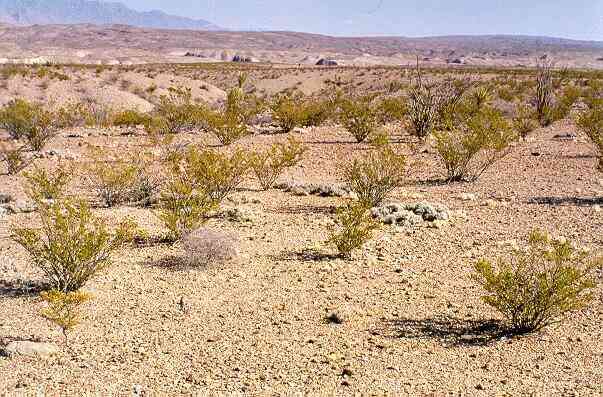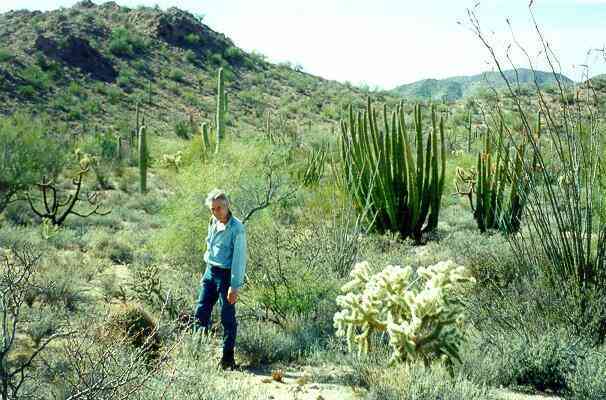|
To some extent the answer to this question is obvious: deserts are dry places, where the availability of water is the major factor that determines the types of organisms that can live there. Typically, a desert is defined as having less than an average 25 cm of precipitation per year. But a more important factor is that deserts have a strong tendency to lose water by evaporation, and this potential for water loss exceeds the annual rainfall. So, deserts are characterised by having sparse vegetation, and the organisms that live in deserts are specially adapted to withstand or avoid water stress. The biosphere, biomes, ecosystems and communities In order to understand life on Earth, we need to take a rather broad view, recognising different levels of organisation.. Individual organisms (species) live in communities with other organisms. Community structure is usually very complex, even if it might appear to be simple at first sight. For example, there are many interactions such as competition, predation and parasitism within a community. And there are various levels of activity - the plants (primary producers) on which all other components of the community ultimately depend, the herbivorous animals that feed on the plants, the carnivorous animals that eat the herbivores, and the microorganisms that degrade the organic matter and thereby recycle the nutrients. All of these components make up the community and - perhaps most important - give it a high degree of stability, because all the components live in balance with one another. Many conservationists now believe that the best way to conserve threatened species is, in fact, to conserve the communities. At the next level of complexity, ecologists study ecosystems - communities of inter-dependent organisms together with all the abiotic (non-living) factors such as climate and soil factors that influence the types of organism that live there. Ecosystems are generally defined by the types of organism they contain - for example, a forest ecosystem, a desert ecosystem, a freshwater ecosystem. At a larger scale, we can recognise similar types of ecosystem across the globe. All the ecosystems of one type are referred to as a biome. For example, the desert ecosystem of central Australia is different from the desert ecosystem of Arizona (USA) or from the ecosystem of the Karoo desert of South Africa. There are different types of plants, animals and even microorganisms in these different places. But these ecosystems also have features in common, which enable us to group them as a desert biome - the scarcity of water, intense solar radiation, relatively poor soils and the special adaptations of the organisms that inhabit all these areas. The advantage of grouping similar types of ecosystem into biomes is that we can describe in general terms all the major types of life zone on earth. Ecologists generally recognise 9 or 10 such terrestrial biomes across the globe (see table below) and several more aquatic biomes. All the biomes of the world make up the biosphere - that part of the planet that contains living organisms.
The sparseness of vegetation in deserts contrasts with the higher density of vegetation in wetter biomes. The effect of this is illustrated in the image below, which shows remote (satellite) monitoring data on the gross primary productivity (grams of carbon produced per square metre) in different parts of the USA.
Compare the image above with the one below, and we see that some of the areas of lowest productivity match closely the areas of the main North American deserts.
There is an interesting corollary to this: when we look at the structure of desert communities we find something quite different from the structure of communities in other biomes. In the wetter and more productive biomes the plants compete mainly for light. In fact, the most productive biome - tropical rainforest - has a vertically structured community of plants, with canopy trees, climbers, understorey trees and shrub and ground layers. Here the main factor is competition for light. A desert biome is entirely different from this because there is seldom, if ever, competition for light. Instead, the desert plants compete for water, and their usually wide spacing reflects competition of their root systems for water capture. If a patch of desert is cleared of vegetation then the same species will reappear, spaced out to exploit the available water, because these are the only species adapted to withstand the rigours of drought. What do these deserts look like? The answer is that they are extremely diverse. [See North American Deserts]. Vast tracts of them are extremely monotonous, like the hundreds of square kilometres dominated by creosote bush in the lower, drier parts of the Sonoran Desert (image below). But others have a much higher species diversity, like the somewhat wetter upland regions of the Sonoran Desert (second image below).
Part of the difference between these two desert scenes is the availability of water. But equally important is the structure of the soil - the mixture of particle sizes has a major influence on how much water the soil can retain. Desert soils tend to be poorly developed, with a high content of mineral particles but little organic matter. This is caused by the low plant productivity, which restricts the soil-building properties of microorganisms that convert organic matter into the humus components of soils.All these factors are inter-related, because soils with a low organic matter content have a low water-holding capacity - they cannot retain all the water that falls onto them. In addition, the intense evaporation of water from desert soils tends to bring dissolved salts to the surface. The high surface content of sodium and calcium ions can lead to extensive saltpans, where little or nothing can grow. |



